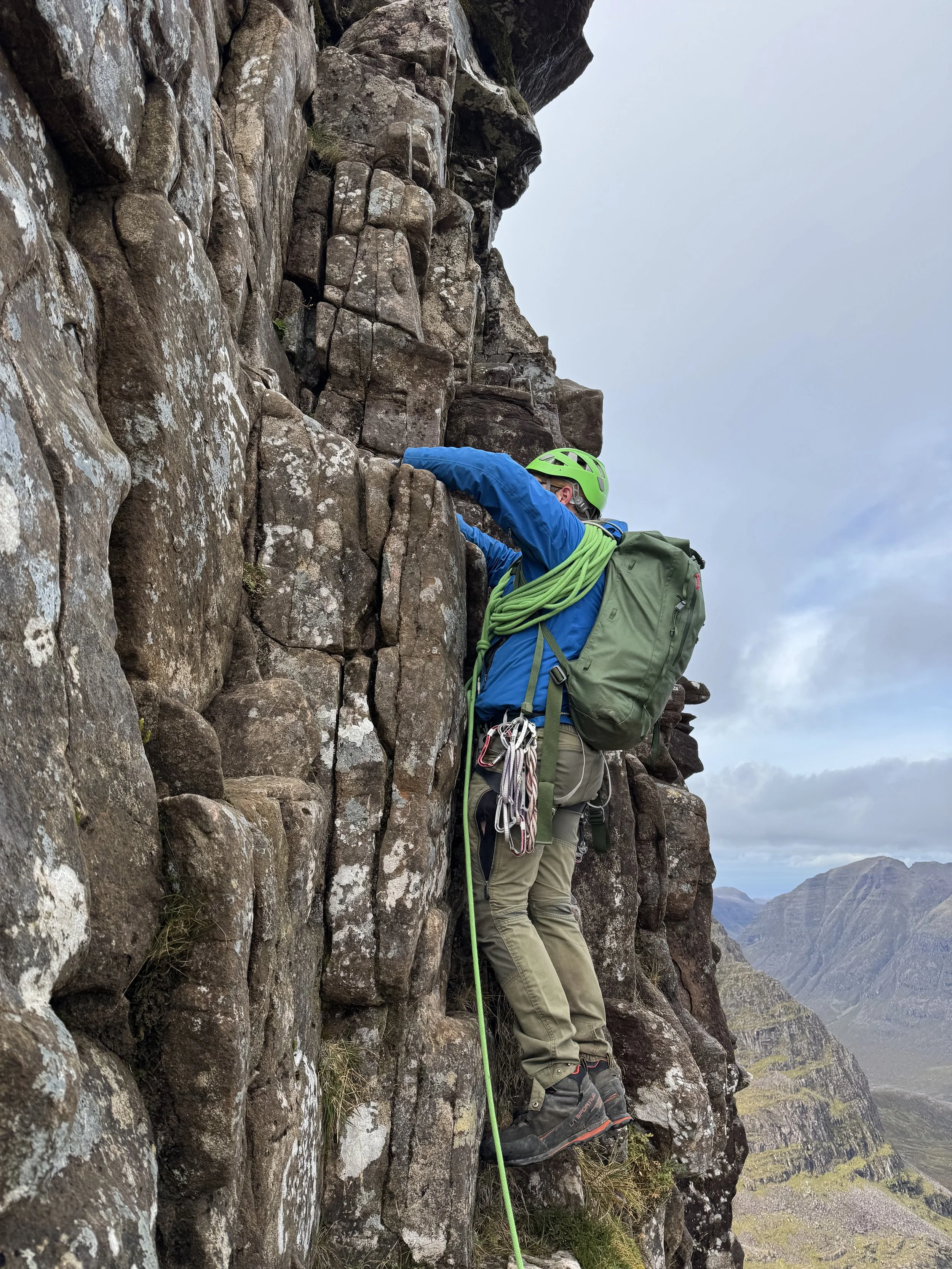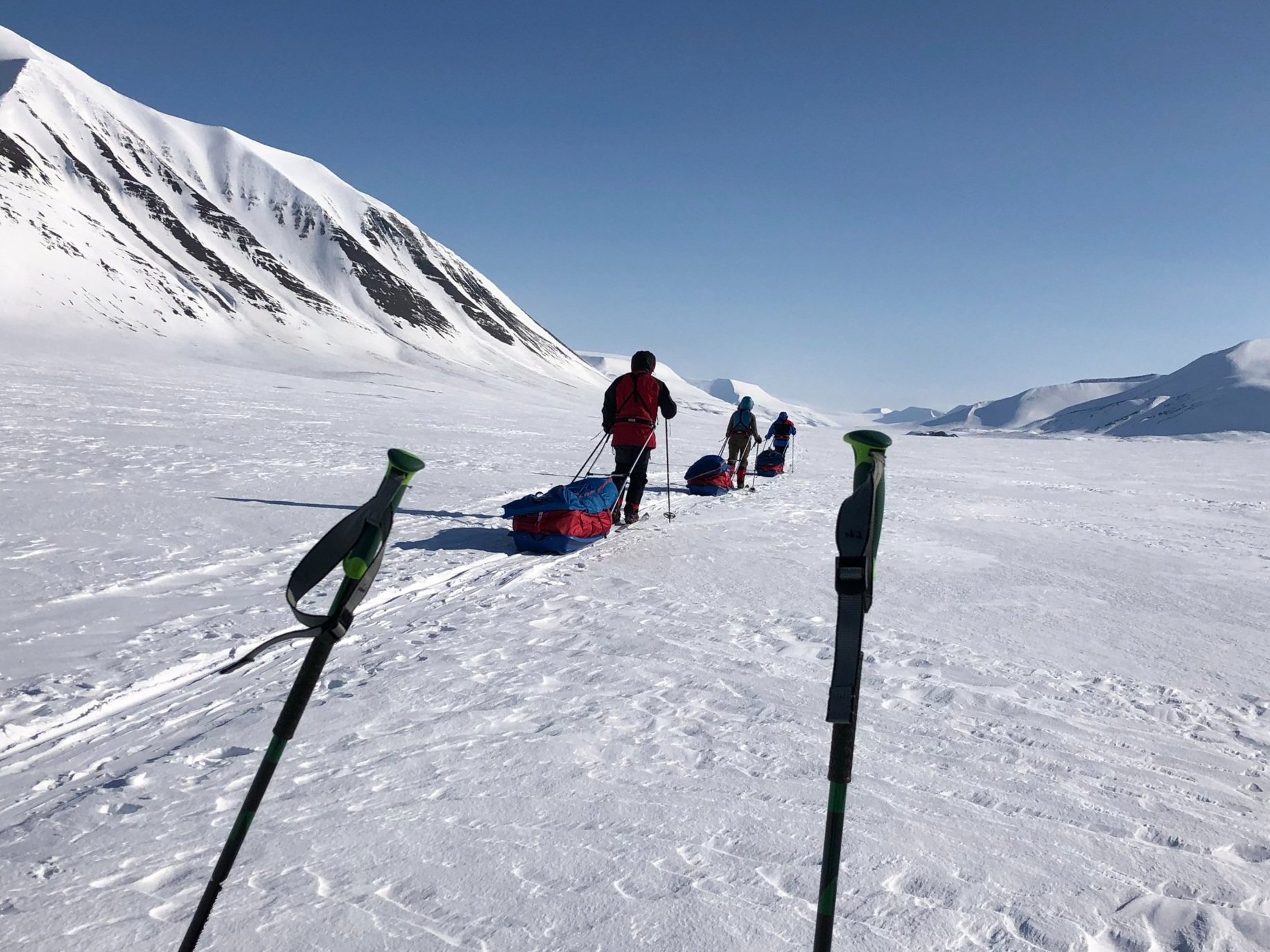
Svalbard Crossing and Newtontoppen Summit
A Self-Supported Arctic Expedition
4th - 18th April 2026
Svalbard has that undeniable pull of the North. It occupies a special place on the edges of the map where your eye searches north, further north – and there it is. Cloaked in snow, shaped by the presence of polar bears, Svalbard stands apart from other snowy places. It has a unique remoteness, an ‘otherness’ that calls to a certain type of person - someone who can put their head down and keep trudging to cover the last miles of the day, someone thriving on the routines of expedition life, and longing to see what’s behind that next hill and the next. Always pushing beyond the horizon line. Svalbard is challenging, vast, and always a step beyond.
This expedition is an 11-day self-supported crossing, taking in the summit of Newtontoppen, the highest peak in Svalbard. Before taking the skidoo transfer into the wild, we prepare in Longyearbyen, practising polar bear protection and checking our gear. From there, the journey begins on skis, pulling pulks and camping in polar tents.
The Crossing Highlights
Summit Newtontoppen, the highest peak in Svalbard
250km Self supported on skis
Learn the skill of polar bear protection
Use the best polar equipment: pulks and Hilleberg tents
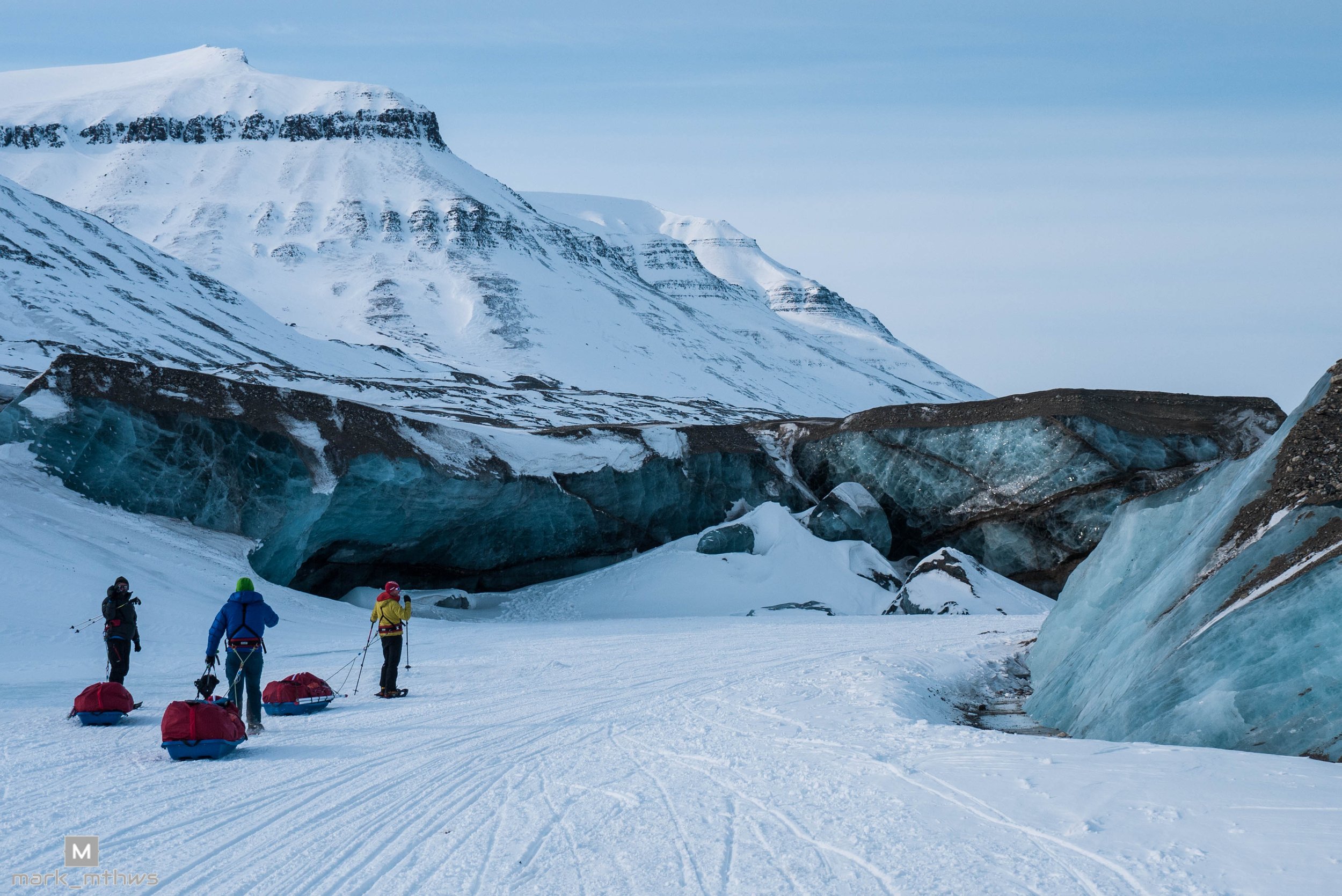
What to expect during your Svalbard Crossing
Explore Longyearbyen, a historic coal mining town, home to a museum, restaurants and hotels, and a good place for R&R after the expedition.
Learn the routines of expedition – set up tent and tripwire system, dig the cold air-well, and enjoy simple comforts like chocolate warmed in your pocket or a hot sweet drink at lunch break.
Teamwork: Work as part of a small team, sharing the load of daily tasks like setting up camp, cooking, and keeping watch.
Perfect your ski technique – learn how different snow and temperature affect your movement, apply waxes and skins to adapt to the terrain.
Take time for observation – long nights spent on polar bear watch, letting the eye and mind wander; taking time to photograph the incredible scenery; looking out for arctic foxes, reindeer, and maybe even a glimpse of a polar bear.
Summit Newtontoppen: Reach the highest peak in Svalbard, with views that mark the culmination of the journey.
We only have limited places on each expedition, get in contact today and reserve your spot on our next adventure.

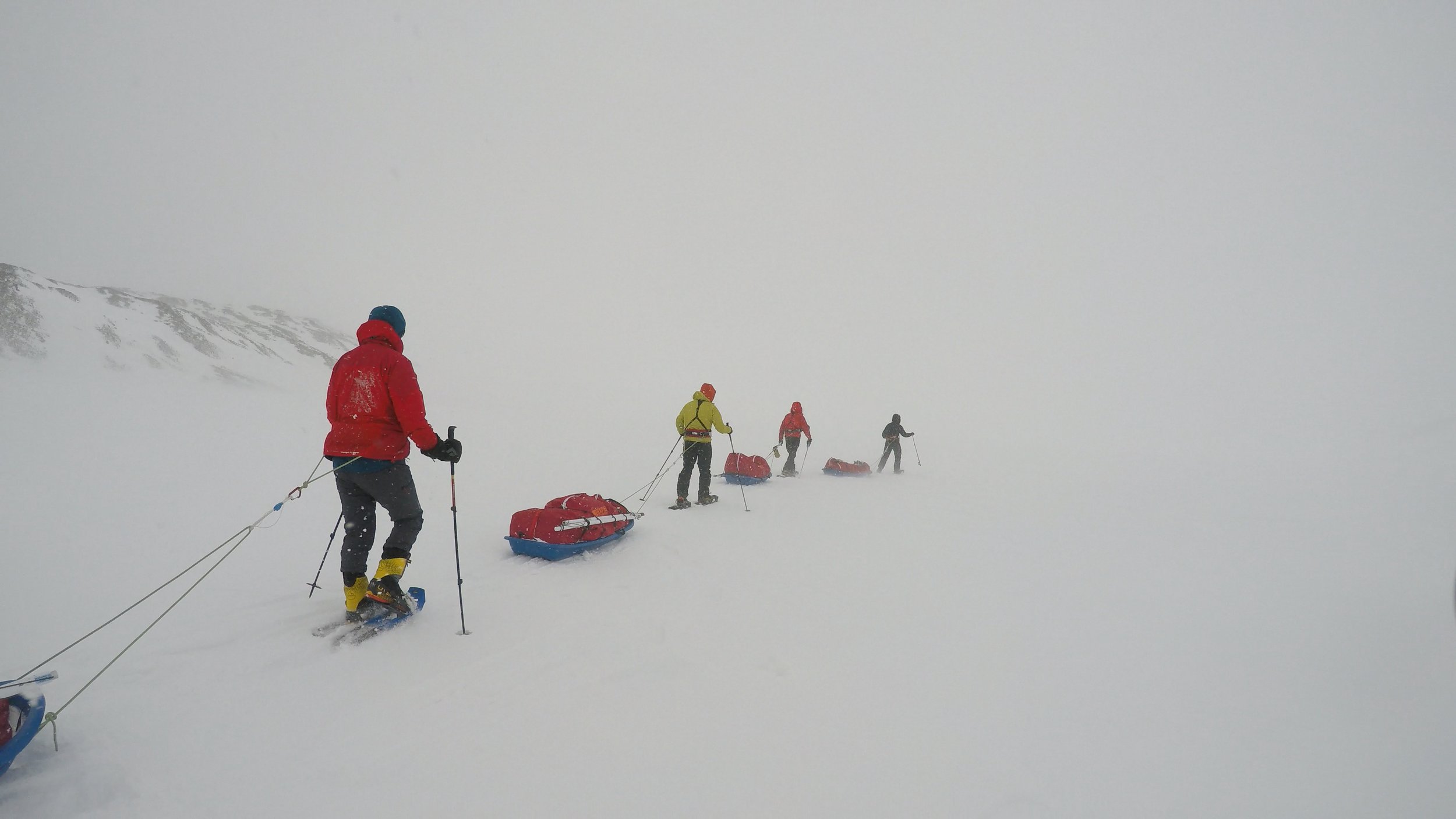
Expedition Safety
Your Safety is Our Top Priority on Every Trip
Your guides will have overall responsibility for polar bear protection and will carry the rifle; they are trained and experienced in polar safety. A thorough safety briefing will take place in Longyearbyen before the expedition begins, as well as during the lead-up to the trip. A UK-based training course will cover the equipment and how to use it, ensuring you feel familiar with handling everything from setting up Hilleberg tents to operating the stoves.
There will always be time to go over skills again and practice. The aim is to get you self-sufficient and confident. By the halfway point of the journey, packing up camp, loading your pulk, and clipping into your bindings will feel like second nature, and the daily routine will become quicker and more efficient.
All of our guides are qualified and have been working with us for many years. They hold up-to-date first aid, Wilderness First Aid, and avalanche safety qualifications. You can visit our Team page to find out more about each guide’s background and experience, and the different qualification schemes.


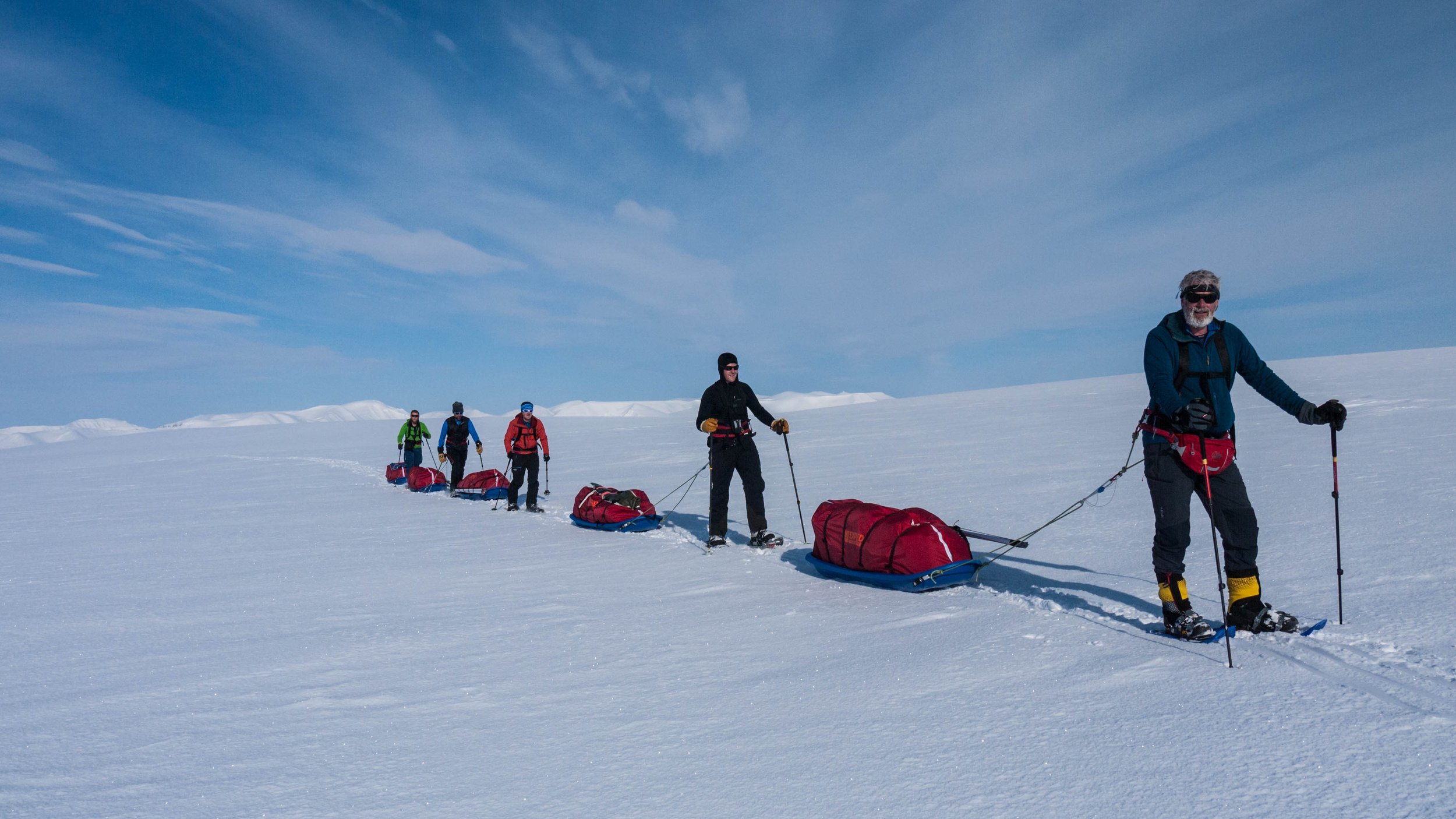
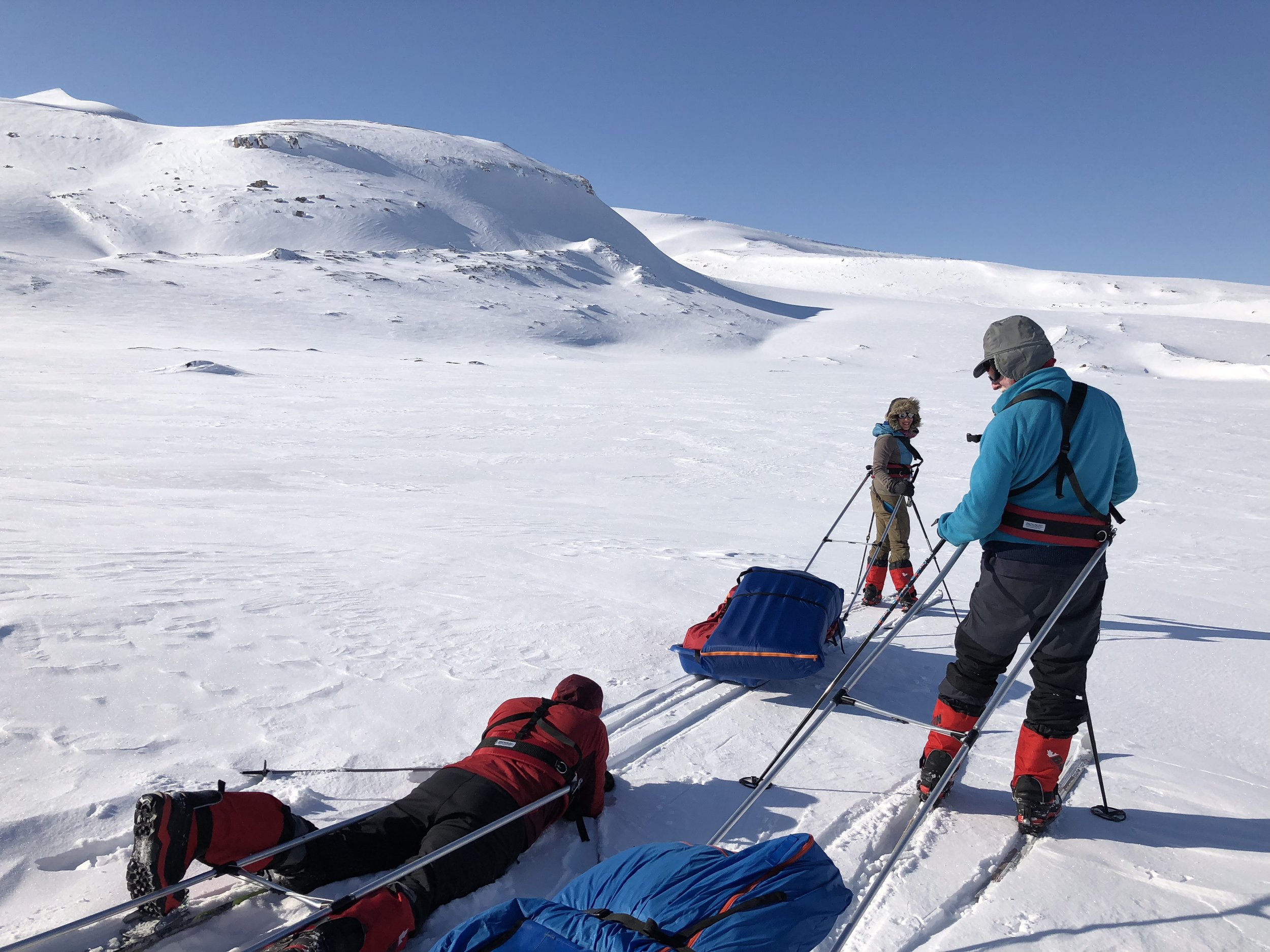

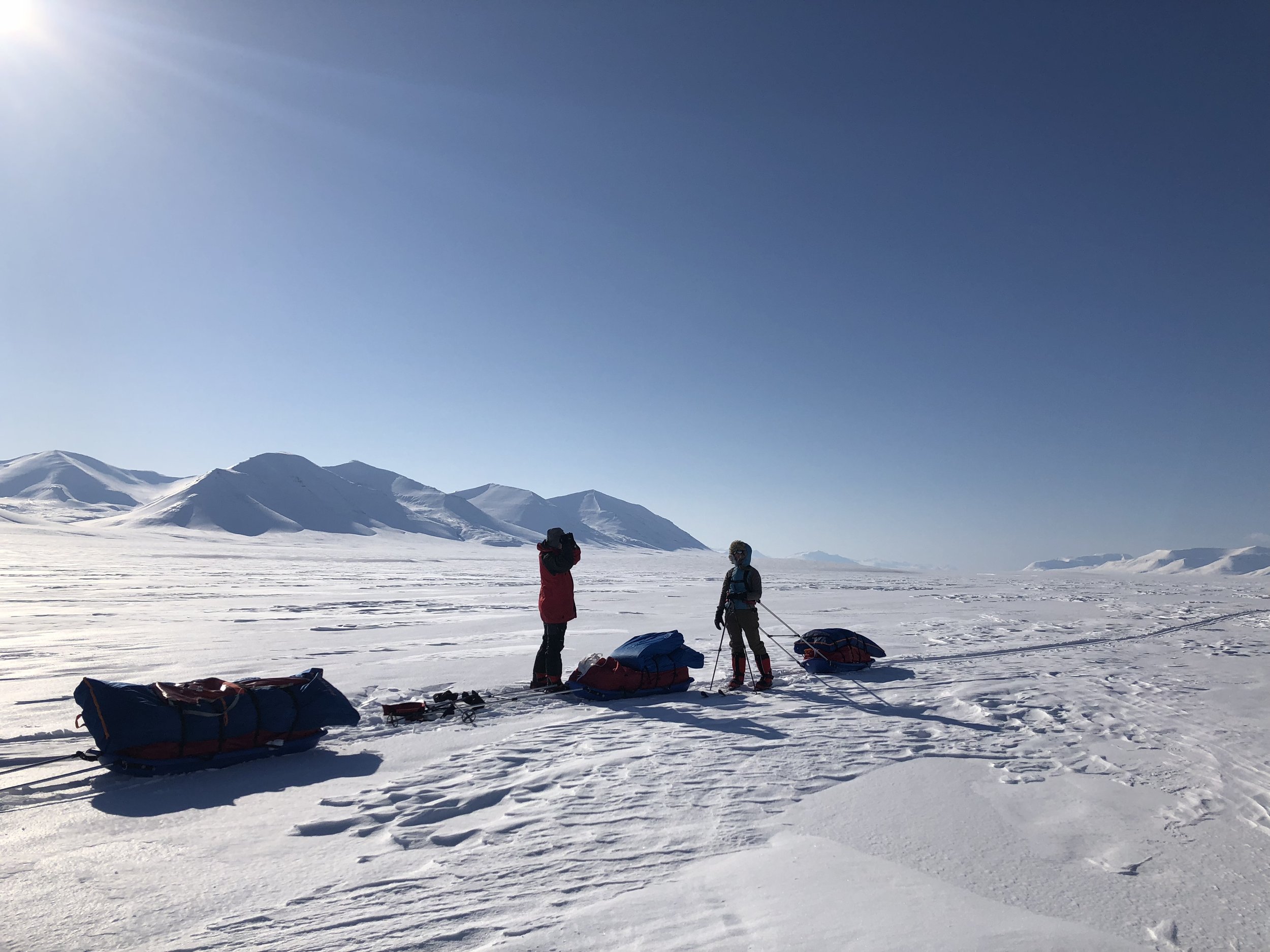

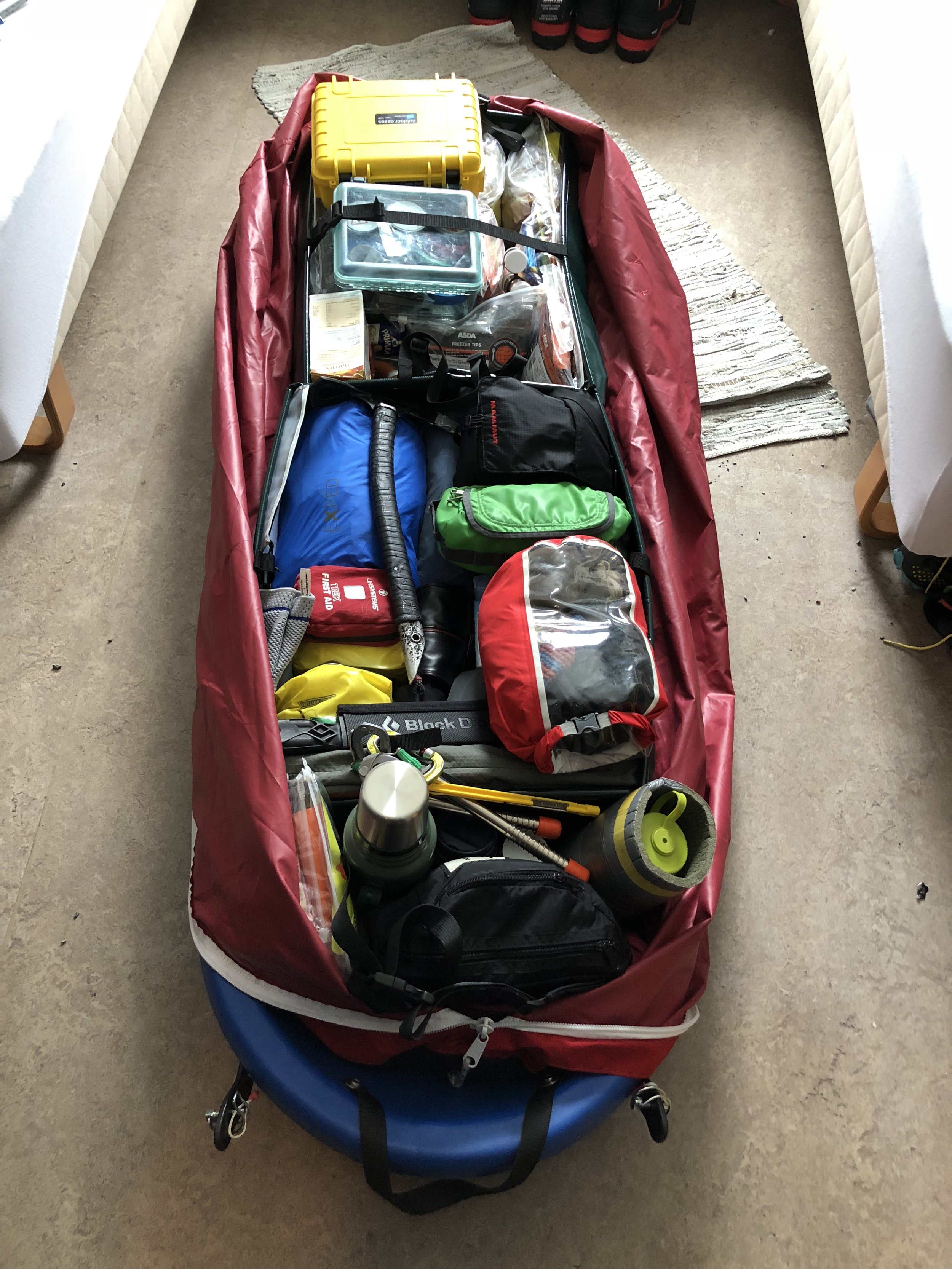

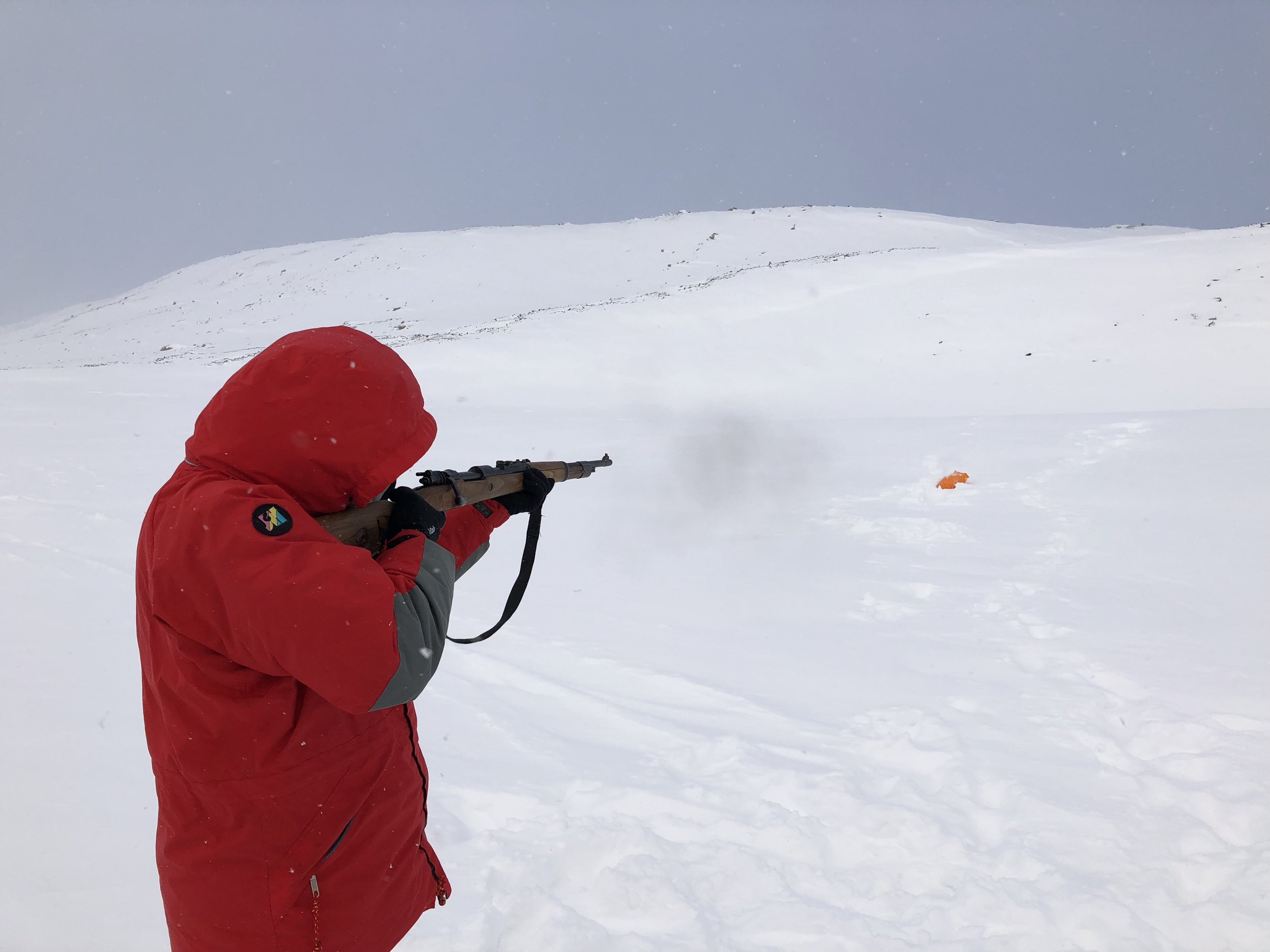








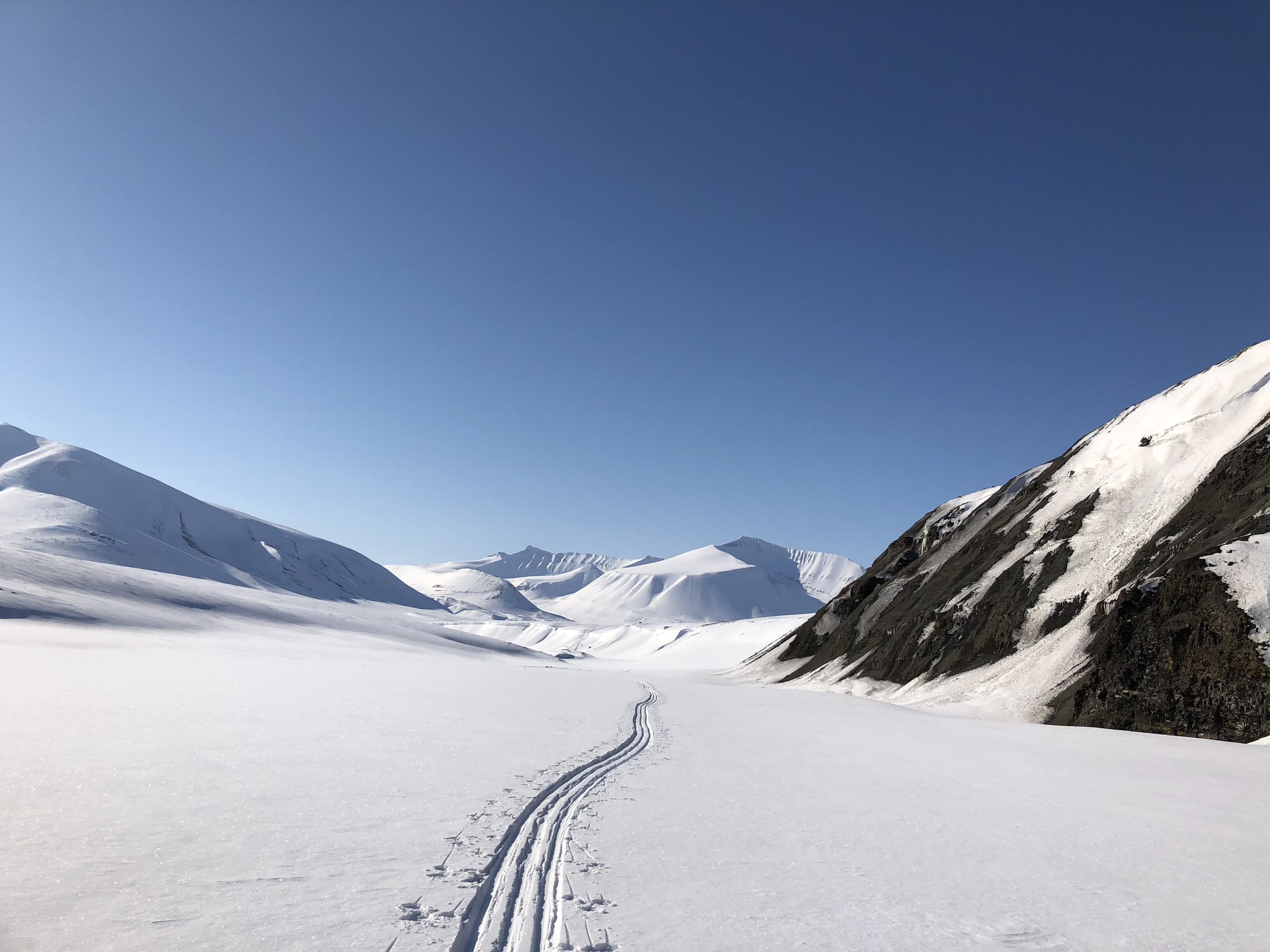


Your Svalbard Crossing Expedition Itinerary
Available Trip Departures
4th - 18th April 2026
Day 0/01: Arrive and Prepare for the Arctic Challenge
Today will be a busy day from the moment you land in Longyearbyen. Whether arriving on an early flight or having come the day before, we’ll hit the ground running with essential expedition preparations. We’ll gather to discuss any last-minute updates, then move on to testing the gear you’ll rely on in the field—stoves, tents, pulks—ensuring everything is in working order for the journey ahead.
Polar bear safety is a top priority, so we’ll take time to refresh our emergency protocols, covering bear watches, setting up the tripwire system, and handling the flare pistol and rifle. Once we’re confident in our systems, it’s time to pack the pulks, double-check everyone’s personal equipment, and fine-tune skis, bindings, and any other necessary gear.
Day 2: Early Start – Skidoo Transfer to Tryggvebreen Glacier (182km)
We begin the day walking our fully packed pulks into town to meet the skidoos at our agent’s depot. With Svalbard’s extreme cold, being a passenger for hours isn’t an option, so we’ll pair up and have a quick, hands-on lesson in driving the skidoos. You’ll be equipped with an oversuit and safety gear before we begin the 9-11 hour transfer north, conditions depending.
It’s a serious journey from day one, taking us deep into the Arctic to set up camp on the Tryggvebreen glacier, high on the ice caps. As Jens departs with the skidoos, we’re left with the reality of the 250 km ski back to civilisation—the true beginning of our expedition. Then, the training, preparation, and routines kick in: tents go up, the stove fires up to melt snow, the perimeter is secured, and of course, watch is maintained, alert at all times.
Day 3: Crossing the Gallerbreen Glacier and Approaching Newtontoppen (24.4km)
Today, we navigate through the dramatic nunataks—isolated peaks jutting through the ice—winding our way up the Gallerbreen glacier. The route skirts across the Veteranen glacier, a narrow but long feature, stretching 50 km yet only 2.8 km wide, like a frozen ribbon through the landscape. This is where the vastness of Svalbard truly begins to unfold.
Heading southeast, we’re met with our first views of Newtontoppen, the highest point on the Svalbard archipelago. The towering presence of the peak looms on the horizon, marking our goal. Tonight, we set up camp on the southeast flank of the mountain, with the North Ice Cap stretching beyond us.
Day 4: Ascent of Newtontoppen and Beyond (26.7km)
We start early today, the only day where we’ll leave our tents in place while we head for the summit of Newtontoppen. After a quick breakfast, we’ll set out, roped together to navigate the crevassed sections of the glacier. The skis will take us most of the way up before we switch to crampons for the final push to the summit, tackling the steeper sections safely. From the top, we’ll take in the expansive views of Svalbard before skiing back down to camp.
Once we’ve returned and had a short rest, it’s time to break camp and continue the journey. We’ll descend into Kvitbreen glacier, pulling the pulks across varied terrain. The route takes us around the striking nunatak, Astronomfjellet, with plenty of ups and downs—not your typical ice cap crossing. The changing landscape adds a different challenge to the day, offering a unique feel compared to earlier parts of the journey.
Day 5: Traversing the Lomonosovfonna Ice Cap (25.1km)
Today, the landscape changes, and we experience the true feeling of being on an expansive ice cap, known locally as "fonna." The terrain becomes much flatter, with very few ups and downs as we travel along the Lomonosovfonna(Lomonosov Ice Cap), named after the Russian scientist Mikhail Lomonosov. This vast snowfield allows us to cover ground efficiently, as we leave behind the rugged features of the previous days. It’s a day to appreciate the sheer scale and isolation of the Arctic. We traverse this breen (glacier) with smooth surfaces stretching out to the horizon.
Day 6: Descending from Lomonosovfonna to the West Coast (24.9km)
Today we descend from the vast Lomonosovfonna ice cap towards the west coast of Spitsbergen. As we make our way down, we ensure our route avoids known polar bear migration and hunting patterns, minimising both the risk to ourselves and our impact on their habitat.
Our journey takes us down toward Tempelfjorden, named after the nearby mountain Templet, which resembles a temple. As we descend, we’ll notice a shift in conditions—the west coast is influenced by the West Spitsbergen Current, which brings warmer waters from the Atlantic. This means there’s typically less sea ice on this side compared to the east. The milder conditions here are due to the warmer, saltier water, which affects both the sea ice and the local ecosystems.
Day 7: Into the Heart of Spitsbergen (25.2km)
Today, we leave the west behind and head back into the centre of Spitsbergen, traversing one of the island’s narrowest sections. By now, you might begin to feel something that’s difficult to describe unless you’ve been here—a sense of flow unique to Svalbard. Each day blends into the next, following a steady rhythm: ski for an hour, rest for 15 minutes, ski again, set up camp, break camp, bear watch, sleep, repeat.
This seamless routine is priceless and, for me, one of the most magical highlights of the expedition. You'll have to trust me until you experience it yourself!
Day 8: From Nordmannsfonna to Hellefonna – A Shift in the Landscape (25km)
Today begins at Nordmannsfonna, where we traverse over to Hellefonna, a glacier area in Sabine Land known for its striking terrain. If conditions allow, we’ll set up camp on Hellefonna for the night. The landscape changes dramatically as we move away from the expansive northern ice caps and enter terrain that feels more alpine. Deep, wide valleys now dominate, flanked by towering peaks that rise steeply on either side.
This is a day for both technical skill and strength. You’ll climb up glaciers, ski down them, and encounter a variety of terrain that will challenge the skiing techniques you’ve learned, as well as test the strong legs you’ve developed over the expedition. The mix of ascents and descents provides a fresh and exciting pace to the journey, making it a rewarding change as we continue deeper into Svalbard’s diverse wilderness.
Day 9: Hellefonna to Oppdalen and Bergmesterbreen (25.7km)
This morning, we have a long descent to look forward to as we make our way down Hellefonna, one of the glaciated areas of Sabine Land, and onto Innerbreen (breen meaning glacier). The route takes us into the Oppdalen valley ("dalen" means valley in Norwegian), offering expansive views as we leave the higher glaciers behind.
But the day doesn’t end there—after enjoying the descent, we’re faced with a challenging climb up the Bergmesterbreenglacier. This climb will test the endurance you’ve built over the last week, pushing your legs and determination. It’s a tough finish, but reaching the top will feel all the more rewarding after the day’s varied terrain.
Day 10: Long Descent and Into the Vast Reindalen (25.1km)
We start the day with a long descent down Drønbreen, passing around Pjalten Peak before skiing down Kokbreen. This brings us into the enormous Reindalen, the largest ice-free valley on Svalbard, stretching about 38 km long and up to 8 km wide. Though glacier-free, this valley will still be covered in snow during our expedition, making it ideal for skiing. In the summer, Reindalen is known for its lush vegetation, but for us, it remains a snow-covered expanse, offering a unique and vast Arctic experience.
Reindalen’s open, expansive terrain contrasts with the glaciers we’ve crossed earlier in the expedition. Moving through this valley, you'll feel the sheer scale of Svalbard’s wilderness, a reminder of how much of the archipelago—around 60%—is still covered by glaciers year-round. This day offers a rare glimpse of Svalbard’s diverse landscapes, from ice-covered glaciers to the wide, snow-blanketed valley floors.
Day 11: Transition from Wilderness to Signs of Civilisation (25km)
Today marks a shift in the expedition as we begin to leave behind the true wilderness. We’ll still be in remote areas, but you’ll start to notice signs of other human activity—occasional skiers or skidoos, distant huts, or the sight of reindeer and dog sled teams passing through. It’s a gradual transition back toward civilisation, but the vastness of Svalbard remains.
We move through the Gangdalen and Todalen valleys today. Gangdalen, located at around 350 metres in elevation, offers expansive views shaped by long-term glacial processes. As we continue, we pass through Fritham, a small settlement with a historical significance. During World War II, it was the site of Operation Fritham, a failed mission where Norwegian forces attempted to secure Svalbard’s coal mines from German control. The operation suffered losses, but it marked the beginning of Allied military involvement on the islands
Day 12: Into Longyearbyen – The Final Push (13.3km)
On our last day, we make our way through the valley leading to Longyearbyen, the capital of Svalbard. As we catch our first glimpse of the town, it signals the end of our expedition and the promise of modern comforts—a warm bed, a hot shower, a cooked meal, and, perhaps most importantly, no more bear watch. Tonight, we’ll finally enjoy a full night’s sleep without the constant need for vigilance.
Longyearbyen, once a remote coal mining outpost, has transformed into a hub of modernity at the edge of the world, home to scientists, adventurers, and the northernmost university. The sight of it stirs mixed emotions—relief and excitement for the comforts awaiting us, but also a sense of bittersweet disappointment. After weeks of living in rhythm with the wild Arctic, it’s hard to leave behind the simplicity of life on the trail. There’s a certain magic in the routine we’ve built: the flow of skiing, setting up camp, bear watch, and waking up to the vastness of Svalbard.
You’ll feel the joy of returning to civilisation, but there’s no denying the longing to stay out here just a little longer. The adventure will soon become a memory, and the feeling of pushing yourself in the Arctic wilderness is something you’ll miss as soon as it’s over.
Day 13: Contingency Day -Planning for the Unpredictable
On a journey like this, we always need a contingency plan in case of bad weather or other unforeseen challenges. That’s why we include a rest day, which we can decide to take either for much-needed recovery or if we’re forced to wait out a storm.
During snowstorms on Svalbard’s northern ice caps, snow accumulation can be significant. In particularly severe storms, up to 0.5 metres of snow can accumulate within just a few hours, depending on wind speeds and conditions. These high winds, sometimes reaching over 14 m/s, can transport large amounts of snow, causing dangerous snowdrifts and rapidly changing the landscape
In addition to the rest day, our route is deliberately designed with flexibility in mind. Some parts of the journey include elevation changes and scenic detours that add a sense of variety to the expedition. These sections not only enhance the overall experience but also build in extra distance and time, allowing us to adjust and recover days if bad weather forces us to stop.
As a last resort, we have the option of arranging a skidoo transfer back to Longyearbyen (at individual cost), though this is something we only consider in extreme situations. With multiple layers of mitigation in place, we aim to avoid this, but it's good to know the option exists if needed.
Day 14: Last Evening and Departure: Reflecting and Celebrating (2446km)
As we return to Longyearbyen and settle in for our last evening, it’s time to relax and reflect on the incredible journey we’ve completed. The first order of business is to get our gear dried out—pulk bags emptied, sleeping bags aired, and wet kit laid out to dry. There’s a sense of relief as we finally take off the zinc oxide tape from blisters and laugh about our dodgy sun tans, with the bright Arctic sun leaving some of us with interesting facial patterns.
Sitting around in the warmth of a restaurant, we’ll share stories, laugh at shrunken waistlines, and relive the best moments of the trip. There will be plenty of chatter about the challenges overcome, the breathtaking landscapes we’ve traversed, and the friendships forged in the Arctic cold. As we celebrate our achievements, conversations will inevitably turn to planning the next adventure—because no one leaves Svalbard without feeling the call to return.
The next morning, after a good night’s sleep free from bear watch, we’ll part ways, taking with us unforgettable memories and a bond that only comes from shared adventure in the Arctic wilderness.
The Details
Cost per place on the expedition: £4875
-
Accommodation – 2 night hostel, 12 nights in tents
All in-country transfers, including airport transfers
Meals – All meals on from leaving Longyearbyen D2 to arriving back D13.
Use of pulk system
Mountain tents, stoves + cooking equipment.
Polar bear protection systems. (trip wire system, Signal pistols, high calibre rifle)
Emergency communication systems(sat phone, Inreach)
Expedition food and fuel
Medical safety equipment and supplies
Expedition team leader 1:6 max ratio.
Access to our RMS team of doctors (please see website information for more details)
All necessary permits for leaving the D10 area.
Mandatory UK training course.
-
Skis/snowshoes, boots, skins, poles and other personal expedition equipment. We do provide discount on all the above items that we stock for our customers joining us on expeditions.
Specialist travel insurance (which must include non emergency search and rescue)
Travel to and from departure country.
-
Svalbard in early spring offers more stable weather and 24-hour daylight, but it remains one of the harshest environments on Earth. Journeying north of Newtontoppen onto the remote northern glaciers requires resilience, skill, and preparation.
Storms can deposit metres of snow overnight, sometimes making snow removal through the night essential. Winds barreling down the glaciers can reach hurricane force, and temperatures regularly drop below -40°C. Each day involves covering up to 25km, often breaking trail through deep snow, all while maintaining enough energy to respond to unexpected challenges.
This is a demanding expedition that requires previous experience in remote, self-supported expeditions, particularly in cross-country travel. A solid understanding of your layering system is essential, as is the ability to manage your own equipment and routines efficiently. Beyond fitness and technical ability, this journey demands the capacity to stay focused, adaptable, and ready for the challenges of Arctic travel.
Most importantly, if you are unsure, please get in touch. We’re happy to discuss your skills and experience to help determine whether this expedition is the right fit for you.
-
In Longyearbyen, we start with basic hotel accommodation on a twin-shared basis, offering a comfortable place to prepare for the expedition ahead.
Once out in the wild, we camp in Hilleberg Keron 3GT tents, with two people per tent to ensure plenty of space. These tunnel tents are part of Hilleberg's Black Label range, the most robust on the market, and have been a cornerstone of our expeditions for over 15 years. Designed for extreme conditions, they include features such as double pole sleeves for added strength in high winds and a ventilation system that minimizes snow accumulation by encouraging the outer material to shake off snow buildup. These small but vital details make the Keron 3GT a world-class choice for the harsh Arctic environment.
-
On a polar expedition, the body requires an average of 4,000 to 6,000 calories per day to fuel the physical demands of trail breaking, pulling a pulk, and enduring sub-zero temperatures. Balancing energy needs with food you enjoy is essential—not just for performance but for morale.
We provide bespoke rations tailored not only to meet your nutritional needs but also to include foods you genuinely enjoy. Before departure, you’ll receive a comprehensive food list to review. If there’s something you’d like to add, we’re happy to accommodate—your input helps ensure everything is just right. (Don’t worry—there won’t be any pemmican or seal fat in there!)
Once finalised, your rations will be carefully packed and waiting for you in-country, ready to be loaded into your pulk for the journey ahead. This attention to detail ensures that when you’re out in the Arctic wilderness, you’ll have everything you need to stay fuelled and focused.
-
Please scroll down and you will see the dates :)
Maps for the Svalbard Crossing

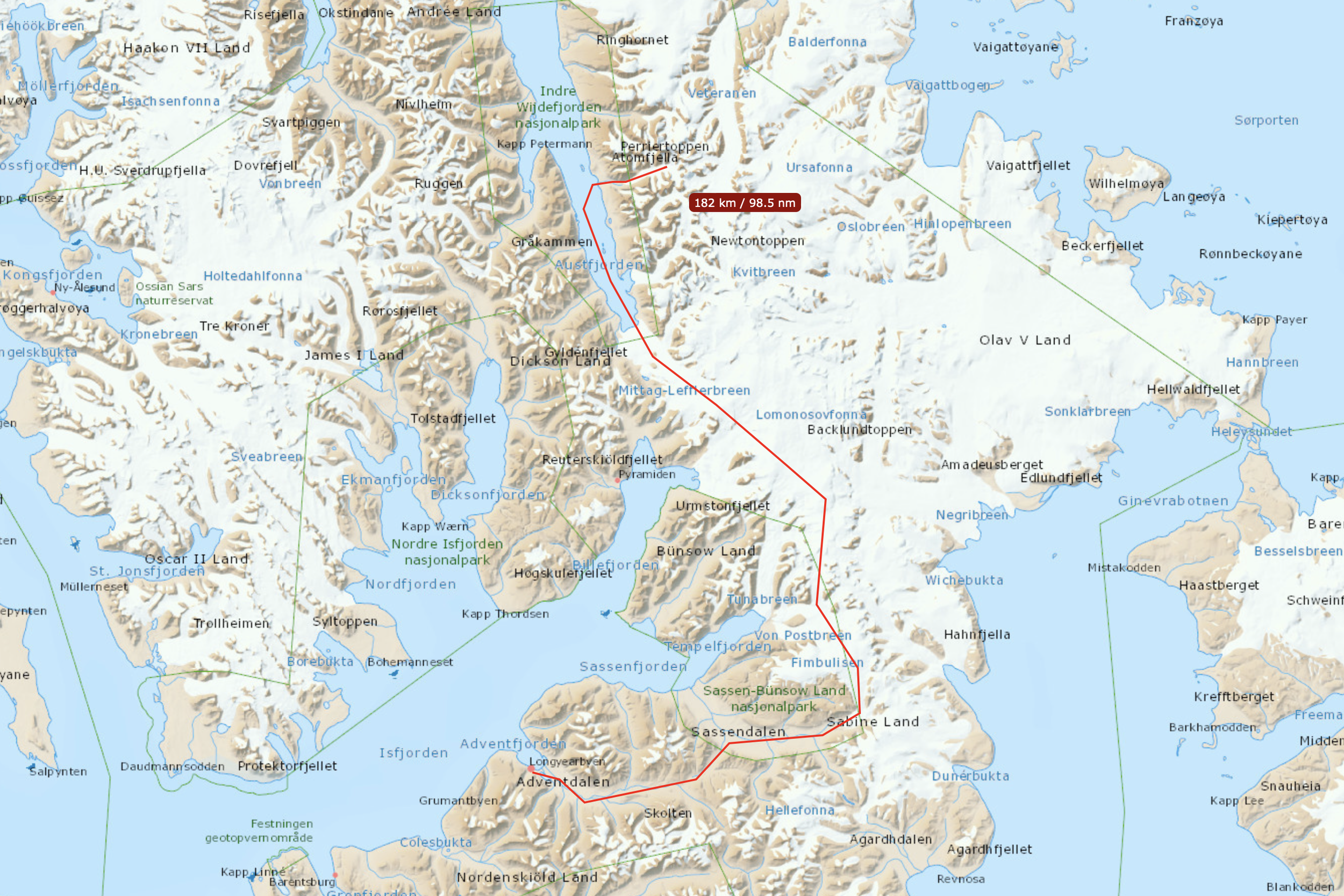










Ready to book the Expedition of a Lifetime?
Available Trip Departures
4th - 18th April 2026

Giving You Unmatched Expertise and Personalisation on Your Trip
Why Choose Nordur for Your Expedition?
Local knowledge
Nordur stands apart in the world of adventure travel with its deep-rooted local expertise. Led by our founder, Jamie, a seasoned guide with over 17 years experience, and is not only a local but a huge enthusiast of the Scottish wilderness, Nordur offers an authentic experience that larger, outsourced tours simply cannot match. We know every hidden trail and secret spot that makes Scotland unique, offering you a richer, more immersive experience.
Sustainability and Respect
At Nordur, we are deeply committed to preserving the stunning landscapes we explore. We practice Leave No Trace principles and engage in efforts to maintain the natural beauty and integrity of the Scottish wilderness. Choosing Nordur means supporting eco-friendly tourism and contributing to the conservation of these magnificent areas for future generations.
Tailored Adventures
Each expedition is carefully crafted to match the desires and abilities of our guests. Nordur specialises in creating personalised experiences that cater to your interests, whether you're seeking thrilling mountain ascents or serene moments by secluded lochs. Our small group sizes ensure that your journey is attentive and responsive to your pace and preferences.
All-Inclusive Expeditions
From high-quality camping gear to expert navigation and safety equipment, everything you need for your journey is provided. Our packrafts are state-of-the-art and we provide you with full training, ensuring that you can navigate the lochs with ease and safety. With Nordur, you can focus fully on your adventure, knowing that all logistical details are expertly handled.
Choosing Nordur means embarking on an expedition where every detail is designed to offer a profound connection with Scotland's natural wonders and cultural heritage. It’s more than just a trek — it’s an expedition into the heart of the wild, guided by those who call it home.
Join us for an unforgettable adventure that pushes your limits and takes you beyond the ordinary, into the extraordinary landscapes of the Scottish Highlands.
Ready for an adventure?
When you come on an expedition with Nordur, it’s not just a trip; it’s a pivotal life experience.
Spaces are limited to maintain the quality and intimacy of the expedition. Reserve your place on this extraordinary adventure today and discover why Nordur's Fannichs and Fisherfield expedition is the ultimate Scottish highland adventure.
Not sure this adventure is right for you? Contact us to discuss our LITE version of this trip.
We also offer a whole range of other bucket list adventures, both in Scotland and Internationally. Check out our other expeditions here or give us a call to discuss your perfect adventure.
Related Blogs

















